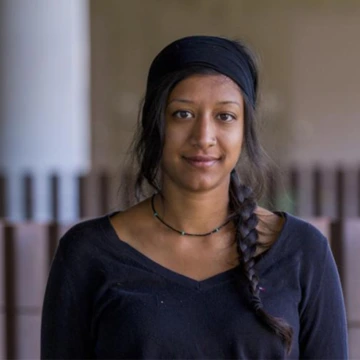Green Infrastructure for Blue Water
Green Infrastructure for Blue Water
Embracing environmental justice to bring water harvesting and green infrastructure to all Tucsonans.
By Craig Baker, Udall Center Communications and Marketing Lead | Dec. 15, 2023
Green Infrastructure: Tucson’s Return to Our Regional Roots
The history of Green Infrastructure (GI) in Tucson, AZ, can be traced back roughly 3,500 years to the Indigenous Hohokam and Tohono O’odham peoples of the region. However, the concept of capturing, storing and utilizing stormwater where it falls is relatively new to modern urban planners and policy makers.
Groundwater has been the preferred source to meet Tucson’s municipal freshwater needs since 1889, when the Tucson Water Company began drilling wells and pumping from underground aquifers. But, as populations grew and local aquifer levels began to drop, it became clear in the mid-to-late 20th century that this source alone was not going to be sufficient to sustain the local population in the long run.
Near the turn of the millennium, local activists and advocates began looking at rainwater and wondering how it might fit into the city’s overall water portfolio. Up to that point, stormwater had been seen as a nuisance to be removed as quickly as possible. Storms meant flooding, property damage and even potential contamination of the potable water supply by litter, pollution and bacteria. But, where previous decision makers had seen a waste product, this new school of experts saw opportunity.

Catalina area flooding, 2004.
Photo courtesy of Pima County Regional Flood Control District.
How Tucson Became an International GI Leader
Contamination concerns meant that stormwater was not ideal for large-scale supplementation of the local drinking water supply, but there was one place where leveraging stormwater as a resource did seem to make sense: urban landscapes.

Neha Gupta, Assistant Research Professor at the Arizona Institute for Resilience.
Hydrologist and Assistant Research Professor in the Arizona Institute for Resilience Neha Gupta points out that “one of the largest uses of domestic water is outdoor irrigation.” In fact, roughly half of the water used by Tucson households goes toward watering outdoor plants.
And so, in the 1990s and early 2000s, researchers, activists and local officials began looking at how they could better control the flow and storage of stormwater to increase vegetative cover and offset the outdoor use of potable water.
One of the first major GI projects in the city, the Ed Pastor Kino Environmental Restoration Project (KERP), was completed in 2001 to better utilize the stormwater collected in a retention basin originally built in 1966 in order to develop a vibrant riparian area, restore local vegetation and provide freshwater for irrigating the nearby recreation areas and ballfields at Kino Sports Complex.
Around that same time, local activist and rainwater harvesting expert Brad Lancaster began a “pre-legal” experiment cutting curbs in his Dunbar Springs neighborhood to allow stormwater to flow into basins adjacent to the street to nourish native vegetation and food plants.
Within a few years, the city not only legalized curb cutting, they actually began incentivizing curb cuts and other rainwater harvesting practices through a rebate program. Other conservation policies followed, such as the 2008 Commercial Rainwater Harvesting Ordinance, which required that new commercial developments meet at least 50 percent of their outdoor irrigation needs with rainwater.
“I feel so proud to be in this community because we're really well positioned for drought and the challenges that face us because we've been doing so much conservation, so much planning.".
Today, Tucson has been recognized as an international GI policy leader by organizations like the U.S. Environmental Protection Agency, the U.S. Water Alliance and the World Bank. And, on Oct. 17, 2023, Tucson’s Mayor and Council approved the city’s proposed One Water 2100 Plan, which officially acknowledges the importance of rainwater as a viable and growing contributor to the city’s water portfolio.

Lightning storm over Tucson, Arizona, during monsoon season.
UArizona Researchers Seek to Advance Green Infrastructure
Researchers at UArizona have consistently been on the cutting edge of GI research and implementation in Tucson and have worked closely with county and municipal partners to study and help improve efforts to utilize rainwater in the desert southwest.
Early efforts on campus included the rollout of a UArizona Water Catchment Group by now-retired Hydrology Professor James J. Riley in 2000, the launch of the Wildcat Curb Cuts program in 2001 and the introduction of the first UArizona rainwater harvesting class in 2006.
Today, UArizona faculty are looking at closing the gaps in our understanding of local weather patterns, hydrology and GI implementation methods to maximize the community benefit of GI.
“It’s an exciting space to be in, both as a researcher, because there are so many open questions,” says Gupta, “and as someone who lives in this community and wants to see it thrive in the future because I can see a very direct line from the research that I do to the quality of life, climate resilience and environmental resilience in this place that I call home.”

Andrea Gerlak, Professor in the School of Geography, Development and Environment, Director of the Udall Center for Studies in Public Policy.
Water policy expert, Director of the UArizona Udall Center for Studies in Public Policy and Professor in the School of Geography, Development and Environment (SGDE) Andrea Gerlak represents the university on two separate public water advisory boards. She also recently worked with municipal partners to help develop a Green Stormwater Infrastructure Maintenance Protocol for the City of Tucson.
“I feel so proud to be in this community because we're really well positioned for drought and the challenges that face us because we've been doing so much conservation, so much planning,” says Gerlak.
Gerlak says that the result of all of this work has been a long-term reduction in per capita water usage in the region. “Our population has been growing, but we've been reducing water consumption and demand."
Related Content
The challenges of the moment, she says, are largely related to how we as a community can stay where we are in terms of consumption in the face of population growth, address our emerging water quality challenges and how to ensure that the fruits of our GI efforts are shared equitably across the community.

Rainwater harvesting is one solution the Tucson residents, policymakers and researchers are experimenting with to embrace green infrastructure.
Environmental Justice and Equity
One of the most pressing concerns surrounding GI development and maintenance in Tucson relates to ensuring that under-resourced communities enjoy the benefits of those programs as much as wealthier communities.
Early rainwater-harvesting rebate programs, for instance, favored homeowners with up to $2,000 in pocket to put toward GI projects up front — a prospect that wasn’t available to renters or property owners living paycheck to paycheck

Adriana Zuniga-Teran, Assistant Professor, Environmental Policy Programs at the Udall Center, and Assistant Professor, School of Geography, Development and Environment.
Udall Center and SGDE Assistant Professor Adriana Zuniga-Teran studies environmental justice with particular attention paid to community engagement and water-related projects.
Zuniga-Teran says that the rebate program was revised so that renters could participate so long as they had the support of the property owner and other tenants. Loans and grants were also made available to low-income participants through the non-profit Sonoran Environmental Research Institute, Inc. to help offset costs. But she suggests that the result of those changes was low-income individuals becoming eligible for the programs “In theory… but not practically.”
In the wake of these early stumbling blocks, officials recognized that a new approach was necessary. Now, says Gupta, officials are looking to ensure that future projects take better account of equity considerations.
“The focus on environmental justice and equity, at least in Tucson, really seems to be a kind of a broad coalition approach,” Gupta says. “There are now many people who are trying to adopt an equity lens in how we plan and implement, and also thinking about how we evaluate these kinds of (GI) features.”
One such development can be seen in the city’s Storm to Shade Program, implemented in 2020, which relies on a neighborhood’s Tree Equity Score to prioritize GI development in underserved areas.
Of course, it will take time for the benefits of this and other equity-focused programs to manifest in low-income communities. “As of today, it's still very much hotter and less green in the south side and low income areas than the north side,” says Zuniga-Teran. But, she says, officials today “are aware of inequalities and are honestly trying to do something about it."
